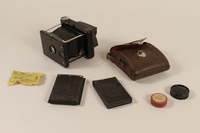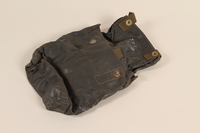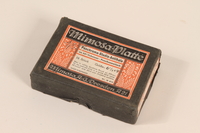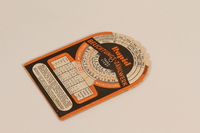Overview
- Brief Narrative
- Kodak Six-20 camera with art deco styling used by Sergeant Walter E. Hunkler, medical technician, 160th Field Artillery Battalion, 45th Infantry Division, known as the Thunderbirds from June 1943 to September 1945. This folding bellows camera was a portable model that took eight large 2 ¼ x 3 ¼ inch shots on a single no. 620 film roll. In July 1943, Walter entered combat in Sicily and then advanced with his unit through Italy, France, and Germany. Walter’s unit was with the 157th Infantry when, on April 29, they arrived with the 45th Infantry at and liberated Dachau concentration camp in Germany. There were nearly 30,000 starving and dying prisoners in need of aid. Walter photographed the camp and prisoners with one of the two cameras that he carried. Walter’s Dachau photographs are part of this collection, 2000.526.1. Walter was awarded a Bronze Star for bravery while tending the wounded.
- Date
-
use:
approximately 1943-1945
manufacture: 1932-1937
- Geography
-
manufacture:
Rochester (N.Y.)
use: Germany
- Credit Line
- United States Holocaust Memorial Museum Collection, Gift of Roberta E. Hunkler
- Markings
- a. front, center, stand, engraved : 015501
a. lens, front top, black panel, embossed : T I
a. lens, front center, black panel, embossed : SHUTTER MADE IN U.S.A. BY EASTMAN KODAK CO., ROCHESTER, N.Y.
a. lens, front bottom, red panel, embossed : KODAK
a. lens, front bottom, black panel, embossed : NO. O KODAL 45724
a. lens, front bottom, metal wheel, engraved, black paint : 1 2 3 4
a. right side, top, film advance, engraved, black paint : USE KODAK / FILM 260
a. interior, front, bellow bellows, label, embossed : SIX-20 KODAK / MADE IN U.S.A. BY / EASTMAN KODAK CO. / ROCHESTER, N.Y.
a. interior, front, lens mount, pencil : n
a. interior, back, label, yellow and black paint : USE KODAK / FILM V-620 / OR 620 / USE KODAK FILM / IN THE YELLOW BOX / It gets the Picture / PATENTED IN U.S.A. / 1,169,882 1,402,167 / 1,211,683 1,435,646 / 1,227,276 1,602,582 / 1,380,810 1,610,175 / PATENTS PENDING / PRINTED IN U.S.A. No. 41,703
d. meter, front center, clear membrane, printed : 1 2 3 4 5 6 7
d. meter, front center, engraved, black paint : 17-18/10 / DIN / Logaphot / System H.C.Lange
f. case lid, top center, embossed : ‘ KODAK ‘
f. case base, bottom center, embossed : Retina / Vorsatzlinse I [additional lens I]
f. lens, top ring, engraved : Kodak – Vorsatzlinse I [additional lens I]
g. case lid, top center, embossed : ‘ KODAK ‘
g. case base, bottom center, embossed : Retina / Grünfilter / 3x [green filter] - Contributor
-
Subject:
Walter E. Hunkler
Manufacturer: Eastman Kodak Company
Manufacturer: Kodak AG
Manufacturer: HC Lange
- Biography
-
Walter Eugene Hunkler was born on February 8, 1915, in Washington, Illinois. He was the second of two children born to John and Bertha Geiger Hunkler. His parents were born in Switzerland and immigrated to the United States. John was a teamster and day laborer. Walter graduated from high school and became a bartender. He married and had a child, but later divorced.
After the December 7, 1941, Japanese attack on Pearl Harbor, Germany declared war on the US and a few days later America entered World War II. On January 19, 1942, Walter was drafted into the US Army. Walter became a medical technician, assigned to a medical detachment, 160th Field Artillery Battalion, 45th Infantry Division, nicknamed the Thunderbird Division. In June 1943, the Division was deployed to Europe. Walter went into combat that July in Sicily, Italy. As the Division advanced through Italy and France, Walter participated in several campaigns: Anzio, Rome-Arno, Southern France, and Ardennes-Alsace-Battle of the Bulge. In spring 1945, the Division advanced into Germany. Walter’s unit was operating with the 157th Infantry when, on April 29, 1945, the 45th Infantry liberated Dachau concentration camp in Germany. They discovered over 30,000 survivors in the camp and 2,310 corpses on a train. Walter witnessed and photographed atrocities, the horrible camp conditions, and the surviving inmates. Following Germany’s May 7 surrender, the 45th Infantry was stationed near Dachau. Walter returned to the US in September 1945, and was honorably discharged as a Technician Fourth Grade in October. He was deployed overseas for 691 Days; 511 of them in combat. He received a Bronze Star for bravery for risking his own safety while tending to the wounded, as well as many battle stars for campaigns where his unit fought.
Walter returned to Washington, Illinois, and worked for the Central Illinois Light Company. In October 1956, Walter married Roberta Leighton (1916 – 2007). Walter did not speak about his wartime experiences. Only once, in 1947, did he allow Roberta to see the photographs he took at Dachau before sealing them inside a storage container where they remained for over fifty years. Walter, 76, died on September 8, 1991, in Peoria, Illinois.
Physical Details
- Classification
-
Audiovisual and Photographic Materials
- Category
-
Cameras
- Object Type
-
Kodak camera (lcsh)
- Physical Description
- a. Folding rollfilm camera in a rectangular, black leatherette covered metal casing with angled corners and side panels covered with black plastic strips set into raised metal edges forming a geometric Art Deco design. The front has a panel with a hinged metal stand that pulls forward to release and raise a metal frame that supports a telescoping black leather bellows with an octagonal enameled lens mount with a clear glass lens with black rings. It has a sliding setting indicator arrow at the top and a flat ridged setting disk at the bottom. At the top left is a shutter lever. At the top right is a pivoting view finder with an interior mirror and 2 clear glass lens: 1 on the front and 1 on top in a cross-shaped frame. The exterior casing has a bottom hinge with a topside metal plate with an engraved arrow and a sliding release to open it. On the upper left is a flat, twisting film advance key on an octagonal mount, with octagonal tripod mounts on the bottom front and left. The back has a circular red plastic window. The interior front has film advance rods on a black metal spool and in the back is a pressure sensitive plate with a painted label.
b. Rectangular, supple black leather camera case with rounded ends, narrow side panels stitched with light brown cord, and a short, V-shaped top flap with a buttonhole stitched with cord. A silver colored metal button is stitched on the front. The interior is suede. There are traces of white paint on the worn exterior.
c. Rectangular, stiff, glossy brown leather camera case with rounded ends, cardboard lined sides attached with brown thread, brown cloth lining. It has a short, top flap with a plated, silver colored metal key-lock. A lock plate with sliding release ring is nailed to the front. The exterior has 2 incised decorative vertical lines. Two short straps are sewn to the case; the left has a buckle and the right has 2 punched holes. A third strap with 4 punched holes and a buckle fastens to these straps to make a roughly 22 inch shoulder strap.
d. Rectangular Bakelite light meter with an offwhite top and a black base. The top has 2 narrow, fixed side panels with grooved inner edges for the side runners from a sliding, removable center panel. On the top center is a column of 7 circular holes, to view the numbers 1 -7 painted in black on clear plastic attached to black coated plastic set between the top and bottom exterior panels. On the base is a column of 7 circular holes which align with the others to allows light in. Measurement intervals are painted black and engraved on the top: aperture range 2 - 22, exposure times 60 to 1/1000 seconds, and light levels 14 -2. It was manufactured between 1938 and 1945. Folded inside is a double-sided card, 1.5 x 1.125 in., with printed instructions in German. The mater and card are kept in a worn, rectangular brown leather slip cover, 2.125 x 1.375 x 0.250 in., with an open top.
e. Removable, black cloth covered flexible cable release for a shutter exposure lever on camera (a). One end is wrapped with black twine and has a small, silver colored metal ball with an open ended cylinder on top. The other, thicker end, has a silver colored metal cylinder with a curved top and a .750 inch rod, now missing a circular head. When depressed, the rod pushes a small cylinder on a spring out the opposite end.
f. Camera lens with a circular, nickel-plated metal case with an embossed base and telescoping lid with a side slit. The interior lid and base are lined with black velvet. Inside is a clear, circula convex glass lens, 1 x .125 in., within a flat black painted, engraved metal ring mounted in a silver colored ridged metal ring with flared sides. The case and lens were manufactured between 1934 and 1945.
g. Circular, nickel-plated metal case with an embossed base and telescoping lid with a side slit. The flat top and bottom have narrow rim extensions. The corroded case no longer opens. It presumably contains a green camera filter. The case and filter were manufactured between 1934 and 1945. - Dimensions
- a: Height: 3.250 inches (8.255 cm) | Width: 5.875 inches (14.923 cm) | Depth: 1.250 inches (3.175 cm)
b: Height: 6.000 inches (15.24 cm) | Width: 3.750 inches (9.525 cm) | Depth: 1.500 inches (3.81 cm)
c: Height: 6.750 inches (17.145 cm) | Width: 4.000 inches (10.16 cm) | Depth: 2.250 inches (5.715 cm)
d: Height: 1.625 inches (4.128 cm) | Width: 1.000 inches (2.54 cm) | Depth: 0.125 inches (0.318 cm)
e: Height: 7.125 inches (18.098 cm) | Diameter: 0.375 inches (0.953 cm)
f: Depth: 0.250 inches (0.635 cm) | Diameter: 1.125 inches (2.858 cm)
g: Depth: 0.250 inches (0.635 cm) | Diameter: 1.125 inches (2.858 cm) - Materials
- a : metal, leather, plastic, glass, paint, enamel paint, pencil
b : leather, cord, metal
c : leather, metal, cloth, thread, cardboard
d : plastic, leather, thread, paper, ink, paint
e : metal, cloth, twine
f : nickel, metal, glass, cloth, paint
g : nickel, metal
Rights & Restrictions
- Conditions on Access
- No restrictions on access
- Conditions on Use
- No restrictions on use
Keywords & Subjects
Administrative Notes
- Legal Status
- Permanent Collection
- Provenance
- The camera and accessories were donated to the United States Holocaust Memorial Museum in 2000 by Roberta E. Hunkler, on behalf of the Estate of her husband, Walter E. Hunkler.
- Funding Note
- The cataloging of this artifact has been supported by a grant from the Conference on Jewish Material Claims Against Germany.
- Record last modified:
- 2023-08-25 16:40:44
- This page:
- https://collections.ushmm.org/search/catalog/irn513191
Download & Licensing
In-Person Research
- By Appointment
- Request 21 Days in Advance of Visit
- Plan a Research Visit
- Request to See This Object
Contact Us
Also in Walter E. Hunkler collection
The collection consists of two cameras, camera accessories, a cloth pouch, documents, and photographs relating to the experiences of Walter E. Hunkler, medical technician, 160th Field Artillery Battalion, 45th Infantry Division, United States Army in combat in Europe during World War II, including the liberation of Dachau concentration camp in Germany.
Date: 1942-1945 August

Goerz Tenax pocket camera and accessories used by US soldier
Object
Goerz Coat Pocket Tenax camera and photographic accessories used by Sergeant Walter E. Hunkler, medical technician, 160th Field Artillery Battalion, 45th Infantry Division, known as the Thunderbirds, from June 1943 to September 1945. In July 1943, Walter entered combat in Sicily and then advanced with his unit through Italy, France, and Germany. Walter’s unit was with the 157th Infantry when, on April 29, they arrived with the 45th Infantry at and liberated Dachau concentration camp in Germany. There were nearly 30,000 starving and dying prisoners in need of aid. Walter photographed the camp and prisoners with one of the two cameras that he carried. Walter’s Dachau photographs are part of this collection, 2000.526.1. Walter was awarded a Bronze Star for bravery while tending the wounded.

Wehrmacht waterproof gas cape pouch found by US soldier
Object
German gas cape pouch found by Sergeant Walter E. Hunkler, medical technician, 160th Field Artillery Battalion, 45th Infantry Division, known as the Thunderbirds, from June 1943 to September 1945. The pouch was worn on a German soldier’s chest, attached to gas mask pouch shoulder strap. Walter may have used it to hold binoculars. In July 1943, Walter entered combat in Sicily and then advanced with his unit through Italy, France, and Germany. Walter’s unit was with the 157th Infantry when, on April 29, they arrived with the 45th Infantry at and liberated Dachau concentration camp in Germany. There were nearly 30,000 starving and dying prisoners in need of aid. Walter photographed the camp and prisoners with one of the two cameras that he carried. Walter’s Dachau photographs are part of this collection, 2000.526.1. Walter was awarded a Bronze Star for bravery while tending the wounded.

Mimosa 6.5 x 9 cm sheet film box used by US soldier
Object
Mimosa sheet film box used by Sergeant Walter E. Hunkler, medical technician, 160th Field Artillery Battalion, 45th Infantry Division, known as the Thunderbirds, from June 1943 to September 1945. The box held 6.5 x 9 cm film sheets which would fit the Tenax camera that he used during the war.In July 1943, Walter entered combat in Sicily and then advanced with his unit through Italy, France, and Germany. Walter’s unit was with the 157th Infantry when, on April 29, they arrived with the 45th Infantry at and liberated Dachau concentration camp in Germany. There were nearly 30,000 starving and dying prisoners in need of aid. Walter photographed the camp and prisoners with one of the two cameras that he carried. Walter’s Dachau photographs are part of this collection, 2000.526.1. Walter was awarded a Bronze Star for bravery while tending the wounded.

Photographic light exposure calculator used by US soldier
Object
Cardboard photographic light meter used by Sergeant Walter E. Hunkler, medical technician, 160th Field Artillery Battalion, 45th Infantry Division, known as the Thunderbirds, from June 1943 to September 1945.In July 1943, Walter entered combat in Sicily and then advanced with his unit through Italy, France, and Germany. Walter’s unit was with the 157th Infantry when, on April 29, they arrived with the 45th Infantry at and liberated Dachau concentration camp in Germany. There were nearly 30,000 starving and dying prisoners in need of aid. Walter photographed the camp and prisoners with one of the two cameras that he carried. Walter’s Dachau photographs are part of this collection, 2000.526.1. Walter was awarded a Bronze Star for bravery while tending the wounded.
Walter Hunkler papers
Document
Contains two documents titled allowing U.S. military officer to possess and/or mail "captured enemy military equipment," retrieved and used by Sergeant Walter Hunkler, dated August 20, 1945. One envelope with "Dachau" written on front and "44." Group of black and white photographs from Dachau, taken by Sergeant Hunkler, and othes gathered in Germany after liberation of the camp. The documents belonged to Walter Hunkler (donor's husband), Sergeant, assigned to medical detachment of the 160th Field Artillery Battalion, a unit of the 45th armored division that entered concentration camp Dachau in Germany on April 29, 1945.



